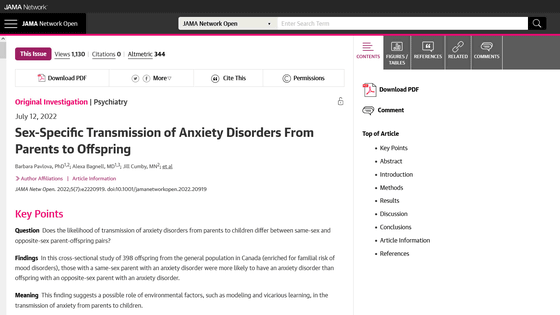Anxiety disorders are more likely to be inherited from same-sex parents

It is known that '
Sex-Specific Transmission of Anxiety Disorders From Parents to Offspring | Anxiety Disorders | JAMA Network Open | JAMA Network
https://doi.org/10.1001/jamanetworkopen.2022.20919

Anxiety Is More Likely to Be Passed From Mother to Daughter, New Study Finds
https://www.sciencealert.com/mothers-more-likely-to-transmit-anxiety-disorders-to-daughters-than-sons
Dr. Barbara Pavlova, a psychologist at Dalhousie University in Canada, conducted a cross-sectional study in Nova Scotia with the help of 398 children and their parents from 2013 to 2020.
Participants were families at high risk of anxiety disorders, including 398 children (195 men, average age 10.6 years / 203 women, average age 11.1 years), 237 fathers, and 221 mothers. In addition, as a control family, families were gathered from the neighborhood and the same school district. An analysis that required psychiatric diagnostic information for both parents was performed on a reduced sample of 299 children (149 males and 150 females). The reduced sample had a similar age / gender distribution to the whole.
Of the 398 children, 108 (27.1%) were diagnosed with one or more anxiety disorders. The gender gap was small, with 47 of 195 males (24.1%) and 61 of 203 females (30.1%).
The breakdown is 31 (7.8%) for general anxiety disorder, 25 (6.3%) for social anxiety disorder, 34 (8.6%) for separation anxiety disorder, 32 (8%) for specific phobia, and specific. There were 20 (5%) anxiety disorders and 11 (2.8%) compulsive disorders. Less than 6 people each met the diagnostic criteria for panic disorder, agoraphobia, and post-traumatic stress disorder (PTSD).
The rate of anxiety disorders increased with the age of the child, 21 out of 149 (14.1%) under 9 years old, and 29 out of 56 (51.8%) over 15 years old.
The incidence of anxiety disorders is lowest in children without anxiety disorders in both parents, 42 out of 177 (23.7%), and moderate if either parent is diagnosed with anxiety disorders (54 out of 192). 28.1%), and 12 out of 29 (41.4%) were diagnosed with anxiety disorders by both parents.
Parents with children with anxiety disorders were diagnosed with anxiety disorders with the least schizophrenia in 2 of 32 (6.3%) and the most bipolar disorder in 32 of 89 (36%).
When we examined sex-specific transmission using a reduced sample, we found that same-sex parents transmitted significantly more than heterosexual parents. In addition, maternal anxiety disorders were significantly associated with anxiety disorder diagnosis in female offspring.
In addition, since the incidence of anxiety disorders was high in children in single-parent families, the relationship between parents without anxiety disorders and their children was also investigated. The incidence of anxiety disorders in children living with parents without anxiety disorders is 15 out of 106 (14.2%), which is the incidence of children living with parents without anxiety disorders (1). It was 50 out of 164 (30.5%) and half the incidence of children who did not live with parents without anxiety disorders (43 out of 128 (33.6%)).
Throughout the sample, the presence of fathers without anxiety disorders and mothers without anxiety disorders was not statistically associated with a reduced lifetime incidence of anxiety disorders in children.
In addition, the presence of same-sex parents without anxiety disorders was found to affect the lifetime incidence of anxiety disorders in children, but not significantly for parents of the opposite sex.
Dr. Pablois and colleagues suggest that this study suggests that intergenerational transmission of anxiety disorders is primarily from same-sex parents, especially by treating parents with anxiety disorders. It states that it can prevent the onset of anxiety disorders in children.
Related Posts:







